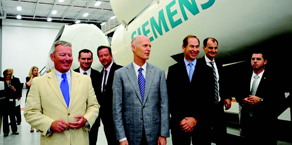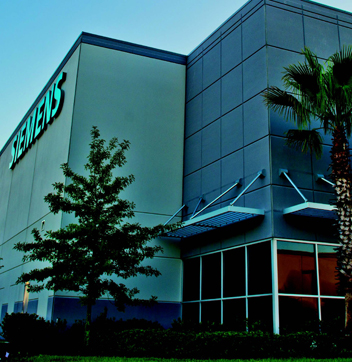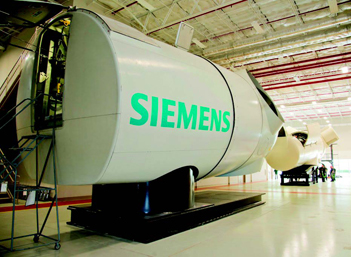ORLANDO, FL – On September 19th, Siemens inaugurated a new 40,000 square foot, $7 million wind service training center in Orlando, built according to US LEED gold building standards and accredited by the Global Wind Organization (GWO) for safety training. Another three Siemens wind training centers are located in Europe – Denmark, Germany and the UK – all are GWO accredited. Randy Zwirn, President and CEO of Siemens Energy Americas welcomed Florida Governor Rick Scott and other state and local government officials, customers and the media including World-Gen. “Our investment in this new training The new Orlando Center has two Siemens nacelles weighing over 100 tons each inside the training center. The Siemens fleet of 2.3 MW wind turbines currently sets the industry standard for availability. The geared 2.3 MW turbines of the G2 platform are optimized for all wind conditions. The Siemens 3.0-MW wind turbines of the D3 platform embody tried and tested innovation in the field of direct drive generators. Siemens direct drive turbines of the D3 offer innovation through the consistent implementation of a common, highly efficient generator concept. With less than half the moving parts of a conventional geared turbine, the direct drive wind turbines improve performance, reliability and maintainability. In addition, the compacted design allows for cost-effective transportation and installation. The Siemens D3 platform offers the simplest and most straightforward wind turbine design. The gearbox is fundamentally the most complex component of a wind turbine, eliminating the gearbox reduces complexity and can increase reliability. Replacing the gearbox, the coupling and the high-speed generator with a low-speed generator eliminates twothirds of the conventional drive train arrangement. As a result, the number of rotating and wear-prone parts is vastly reduced compared to a geared machine. Siemens has opted for a permanent magnet generator for improved efficiency. The wind turbines of the D3 platform have a dual cooling system that provides an even cooling of the generator via a top-mounted, passive cooling system for improved energy efficiency. Siemens offers an innovative and economically-viable tower concept to allow its wind turbines to reach heights above 100 meters. The bolted steel shell tower consists of multiple tower sections, mounted on top of each other and assembled together on site. The modular space concept of the bolted steel shell tower allows for very high hub heights (in excess of 140 meters) with very low transportation requirements. Power conversion is implemented by the Siemens’ NetConverter® system. This system is characterized by full conversion of the power generated, efficiently decoupling generator and turbine dynamics from the grid. The NetConverter® system offers maximum flexibility in the turbine’s response to voltage and frequency control, fault ridethrough and output adjustment. SIEMENS WEBWPS SCADA SYSTEM Via a standard web browser, the Siemens WebWPS SCADA system provides a variety of status views of electrical and mechanical data, operation and fault status, meteorological and grid station data. |
SIEMENS WIND TRAINING CENTER
The new 40,000 square foot, $7 million wind service training center in Orlando.
Both nacelles were manufactured in Denmark. The 3.0 was shipped to Kansas for testing and the
2.3 was originally in Houston; both arrived in Orlando for the new center. |
| WIND TURBINE CONDITION MONITORING Siemens’ wind turbine condition monitoring compares the vibration levels of the main nacelle components with a set of established reference spectra and instantly detects deviations from normal operating conditions. This allows Siemens to proactively plan the service and maintenance of the wind turbines, as any unusual event can be categorized and prioritized based on severity. TURBINE LOAD CONTROL The Turbine Load Control system continuously monitors the structural loading on the wind turbine. In case the loads exceed normal values, the turbine automatically regulates operation to bring loads back within the design envelope. In addition, the TLC system – an optional feature of the D3 platform – monitors the accumulated fatigue loading on the turbine, thereby providing key input for fact-based asset management. Earl Walker, who heads up training and development at the center, said at a press briefing for the media held in one of the new classrooms that one reason Siemens moved from Houston where the first training center was established in 2007, was to find a facility to house the nacelles inside in a climate-controlled setting. Another factor was it being only minutes from the Orlando International Airport, and its close proximity to Siemens corporate headquarters. The center also has three 30-foot high climbing towers, ladder structures, electrical and hydraulic modules, and a service crane station to make training, safety and rescue simulation possible. The center will host more than 2,400 trainees annually from the Americas. Siemens created 50 new full-time jobs associated with the training center. Twenty-five percent are currently held by military veterans. Siemens has hired over 1,000 veterans across its US businesses and is an active participant in the White House Joining Forces initiative as well as Still Serving Veterans to increase training and employment opportunities for returning service members. Seventeen of the new 50 full-time positions are set aside for staff trainers who initially conduct a three week basic training on site. The first week of training is devoted solely to learning safety measures, followed by a three month field training program under supervision. The trainee returns to Orlando for three weeks of advanced classroom training and laboratory work with a return to the field for 6 to 8 months. Siemens currently provides service and maintenance for more than 3,000 installed turbines in the Americas. Maintenance is performed once a year for 40 off-line hours. Since 2007, Siemens has invested over $110 million in wind energy manufacturing and service in North American businesses including a 300,000 sq ft Nacelle assembly facility in Hutchinson, KS; 650,000 sq. ft. blade factory in Fort Madison, IA for more than 8,000 integral blades delivered in the Americas (See world-gen.com “Featured Articles” Sept/Oct 2007); wind turbine R&D center in Boulder, CO focusing on aerodynamics, blade efficiency and meteorology; blade factory in Tillsonburg, Ontario’s first wind turbine blade manufacturing facility, and a 73,000 sq. ft. warehouse distribution and tooling facility in Wichita, KS with seven acres of outside storage. |
|
|
|
|
|
|



